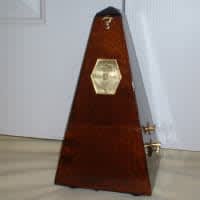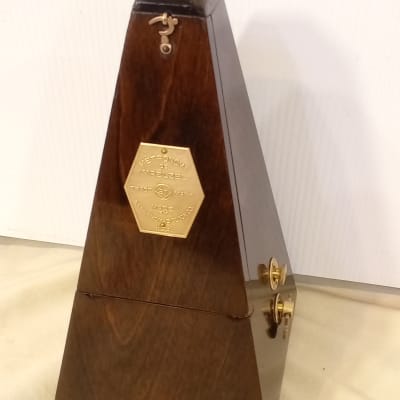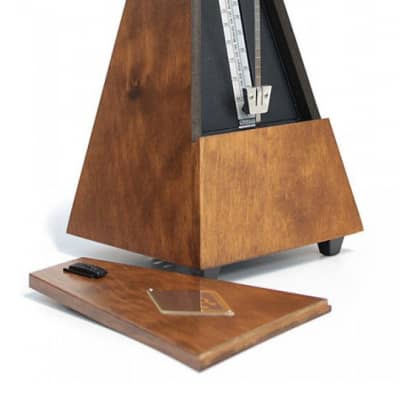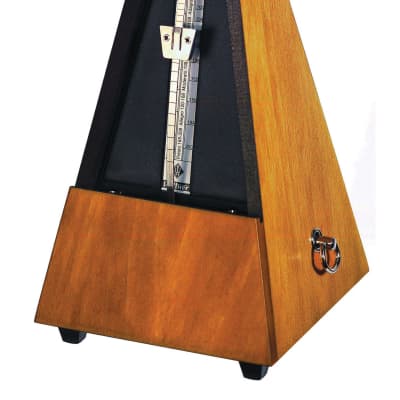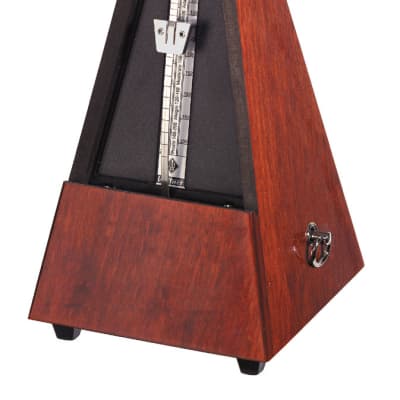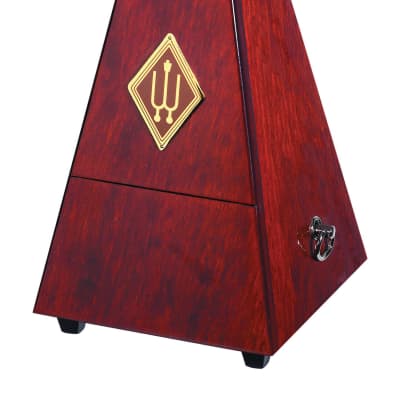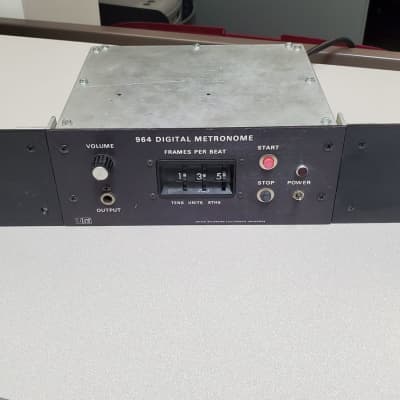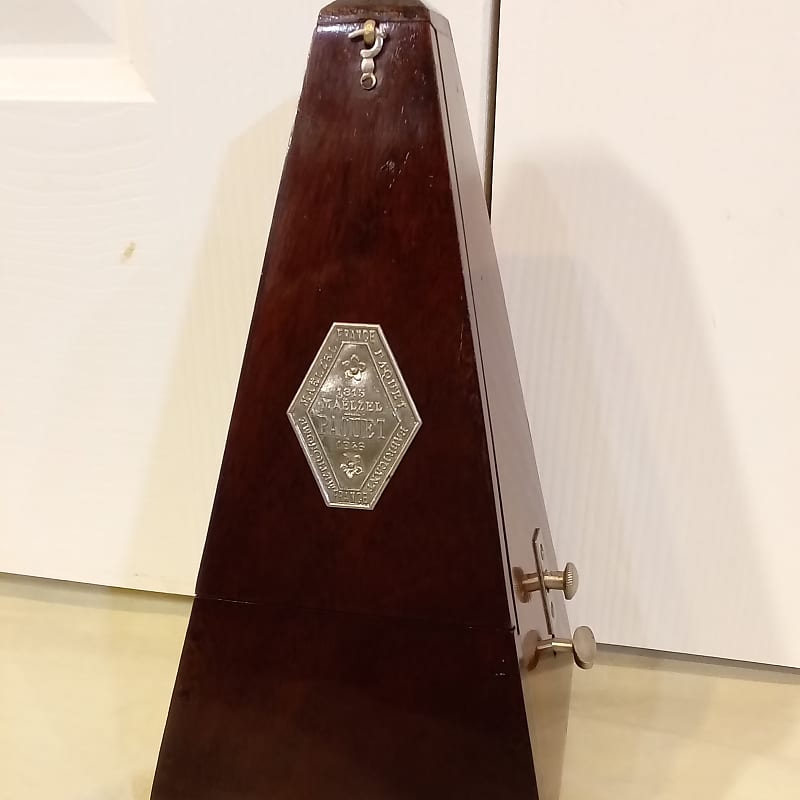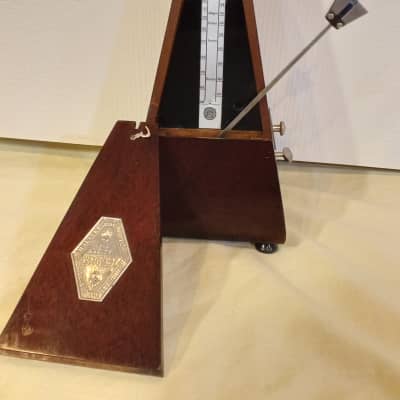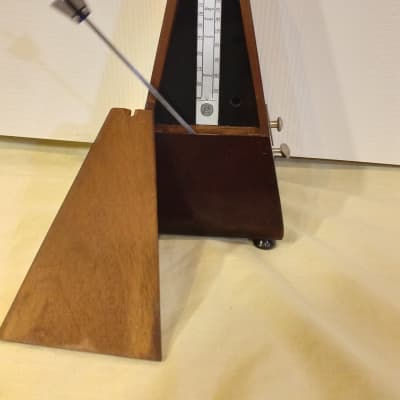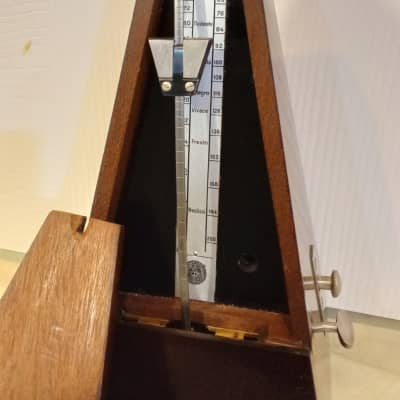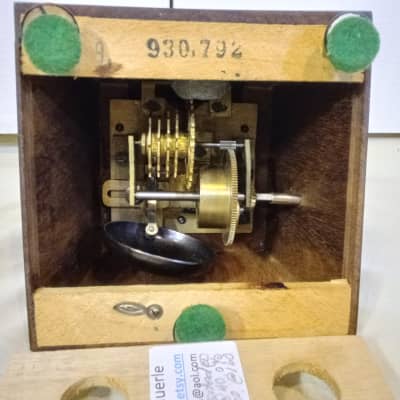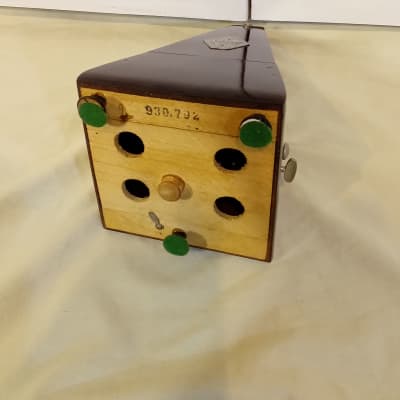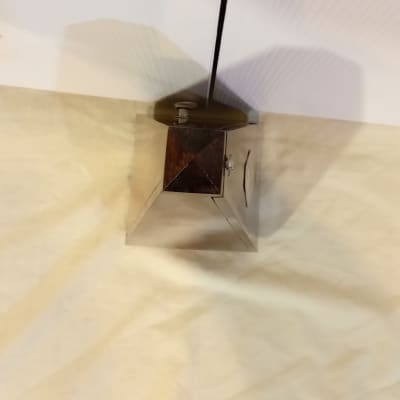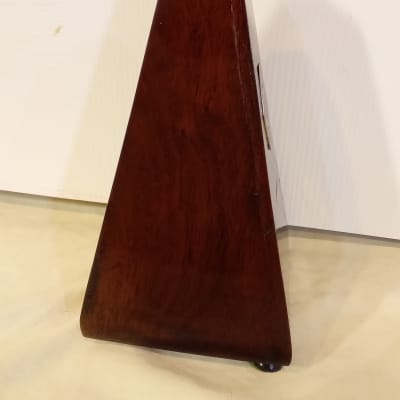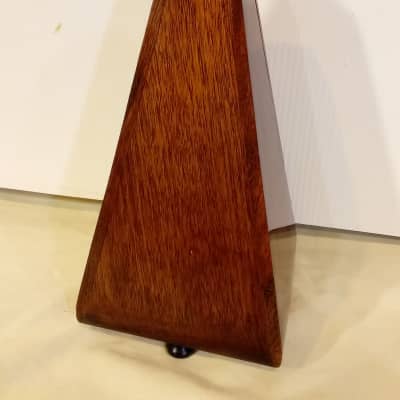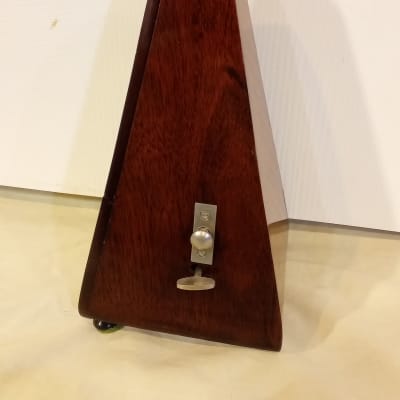This is an all-original and fully restored, French Paquet Paquet Wood Metronome de Maelzel with Rare Bell Chime. My choicest example of this model. It is a real treasure to find and was made I think in the 1940s, but could be older, because many of these companies started producing metronomes in the mid 1800's. This fully serviced metronome runs strong like it was brand new. The unique bell chime on this metronome is a feature you can use to signal the start of a measure that has either 2, 3, 4, or 6 beats per measure. The bell can also be set to not strike at all, so it functions as regular metronome. This is a very useful but rare option not normally seen on metronomes. It is complete with no missing parts. It has a robust and solid wood case with no loose parts, or splits - even the feet pads are solidly attached to the bottom to avoid loss. There are a few finish touch-ups and scuffs in the wood finish on this metronome as would normally be expected from one this old, mainly on the front panel. The back panel is a little lighter shade than the sides. You will probably not find another one of these in this nice of condition with the movement already serviced. Those sellers that do this detailed movement service will say so in their listings. I have included 10 pictures of this metronome in the listing and you can see how beautiful this instrument is! A video with sound of this metronome is included in this listing.
The original finish on all sides shines up well and is stable with no alligator which you should be able to confirm in the close up pictures. The walnut stained wood case is made out of solid wood, possibly birch (no veneers, maybe even some kind of fruitwood, I am not positive) and is a pretty and has uniform bands of lighter and dark brown grain throughout. Visually just stunning. The front dust cover door is the original one, and it fits well over the opening, and it is a perfect match to the rest of the case. The nice decal on the front dust cover door is the original solid silver colored metal plaque with a no scuffs. Since this is vintage or even an antique, there are some very faint signs of age related usage on the instrument as mentioned above. Please see all pictures and notice how beautiful this piece is! I took lots of pictures of this metronome.
It has a mint condition, metal Paquet trademark beat scale with a great contrast between the black beat numbers and the light background. It has a nice silver colored metal plaque on the front made of what appears to be solid metal. Most are brass, so this is pretty rare to find it in silver. It reads "1815 Maelzel Paquet 1846 France Paris" (and other names), and the original movement runs like new. It has a visual pendulum swing with its original sliding weight to adjust the tempo and a very even, loud ticking sound as it runs, and the blue steel bell sounds crystal clear and loud. Note: To keep the weight gripping the stick, there is a thin spring strip that maintains pressure. The weight should only be nudged up and down with pressure applied along the direction of travel. NO pressure should ever be applied pushing the top half inward towards the center, as that would strain the spring strip and cause it to lose grip. The bell strike and the ticking is a little louder than what you would normally find on Seth Thomas metronomes and ticks only a tiny bit softer right at the point it needs to be wound again. In addition, when I found ads for the French made metronomes in The Etude Magazine, they commanded premium prices over Seth Thomas metronomes. The sliding weight grips the stick firmly and stays up where it is set to. The sliding weight glides smoothly over it throughout its whole 40 to 208 range. Beware of other metronomes pictured with the sliding weight slid all the way to the bottom as they probably don't grip the stick. Only a classic mechanical metronome produces the solid and desirable "wood block" ticking sound.
The all-metal movement was just cleaned, adjusted and oiled, saving you at least $260 over other "as found" metronomes. The movement's condition is actually more important to a musician than the look of the exterior case. Note the lack of lint and built up grease and dirt on the close-up picture of my metronome movements that you might find on other seller's metronomes described as being in very good working condition (if you are lucky to even get a close up picture of the movement). Not many of the other metronomes you may find elsewhere get the proper kind of servicing of the movement and you may soon have issues with those other metronomes that have not been serviced. This is a labor intensive service where the entire movement was disassembled, cleaned, each gear was inspected for damage, pivots polished, hard brass bushings added where needed (pressed in from the inside of the movement), mainspring removed, cleaned and lubricated, and re-assembled. This was done for you so you can enjoy it right away rather than waiting on a repair shop. After cleaning, the entire movement was oiled with synthetic clock oil, and then tested. It should not need cleaning again for about 10 to 20 years. I have included a picture of the movement so you can see its inner beauty and cleanliness, which is also rare to find in an antique metronome. Everything is metal in the movement and the bushings are all brass along with the frame, and the arbors are steel. The mainspring barrel is unique in that there is a stop wheel to prevent overwinding, a very useful feature. This metronome was also just calibrated at 80 to 160 beats per minute and will run for over 3000 beats per full winding. It is most accurate at 80 through 200 BPM and within 2% tolerance at 40 BPM, better than most other mechanical metronomes that have come through my shop, pretty amazing. Most importantly: It keeps an even beat whether the sliding weight is set to 40 or 208 - a challenge to find in other metronomes described as "working perfectly".
The cover door has a hook and eye latch that holds the door securely closed, and a tongue and groove on the bottom to fit in the base of the metronome. The winding key is original and is round to protect the finish. Even the tiny finish screws and nails are all original! The bottom cover has a knob and is the original one, and fits well with the original brass catch that rotates so the bottom cover can be easily removed if desired. All three bottom feet are securely attached and tight. This large metronome measures about 9 inches high (as measured from the feet to the very top tip) and 4.5 inches wide.
Many music teachers recommend the mechanical metronome due to its visual swinging pendulum similar to the way the music conductor moves his or her hands. I'm a musician myself and find this fact makes it easier to work with than using an electronic one. This metronome must have been cherished its entire life, and it is looking for a new home on your piano or organ, and most of all, it runs great! Perfect for the collector, or for music lessons. This would also make a great present!
If you are looking to purchase a Maelzel type metronome to use in your own music practice sessions, you have come to the right shop! My restored metronomes keep an even beat when put on a level surface whether the sliding weight is set to 40 or 208 - a challenge to find in other metronomes described as "working perfectly". Note that I'm also a musician in the Livingston Symphony Orchestra who uses a mechanical metronome, so I know what it takes to properly service a metronome. I have yet to find a clock repair horologist that does BOTH the professional repair of mechanical metronomes AND actually use a mechanical metronome for their own music practicing.
This is a premium metronome, unmatched by anything made today. The new ones from Germany made today use plastic in the movement and/or case and feel cheap. This metronome is for one made of all wood, brass and steel, no plastic at all anywhere, period!
These antique metronomes amaze me, they are built to last - can you imagine any other mechanical consumer product still working well after nearly 100 years? The truly amazing thing is with proper care they will work easily for another 100 years, as these movements are made to be serviced as easily or easier as other American clocks from long ago! There are no plastic parts in these movements, only brass plates and gears with steel pinions, pivots and arbors. They hold their value and are an excellent investment to add to your collection and estate.
Note, I have listed this at a price point to reflect the quality of the restoration work and investment. This is important when you consider most metronomes you currently find listed have never been cleaned, calibrated and/or have an uneven beat, and show tarnish on the brass parts. It would be a challenge to find a wood metronome in better cosmetic and mechanical condition.. I have only seen a couple of these in the last several years, and none of those had movements that were cleaned.
Thank you in advance for your business! From a smoke and pet free home.
